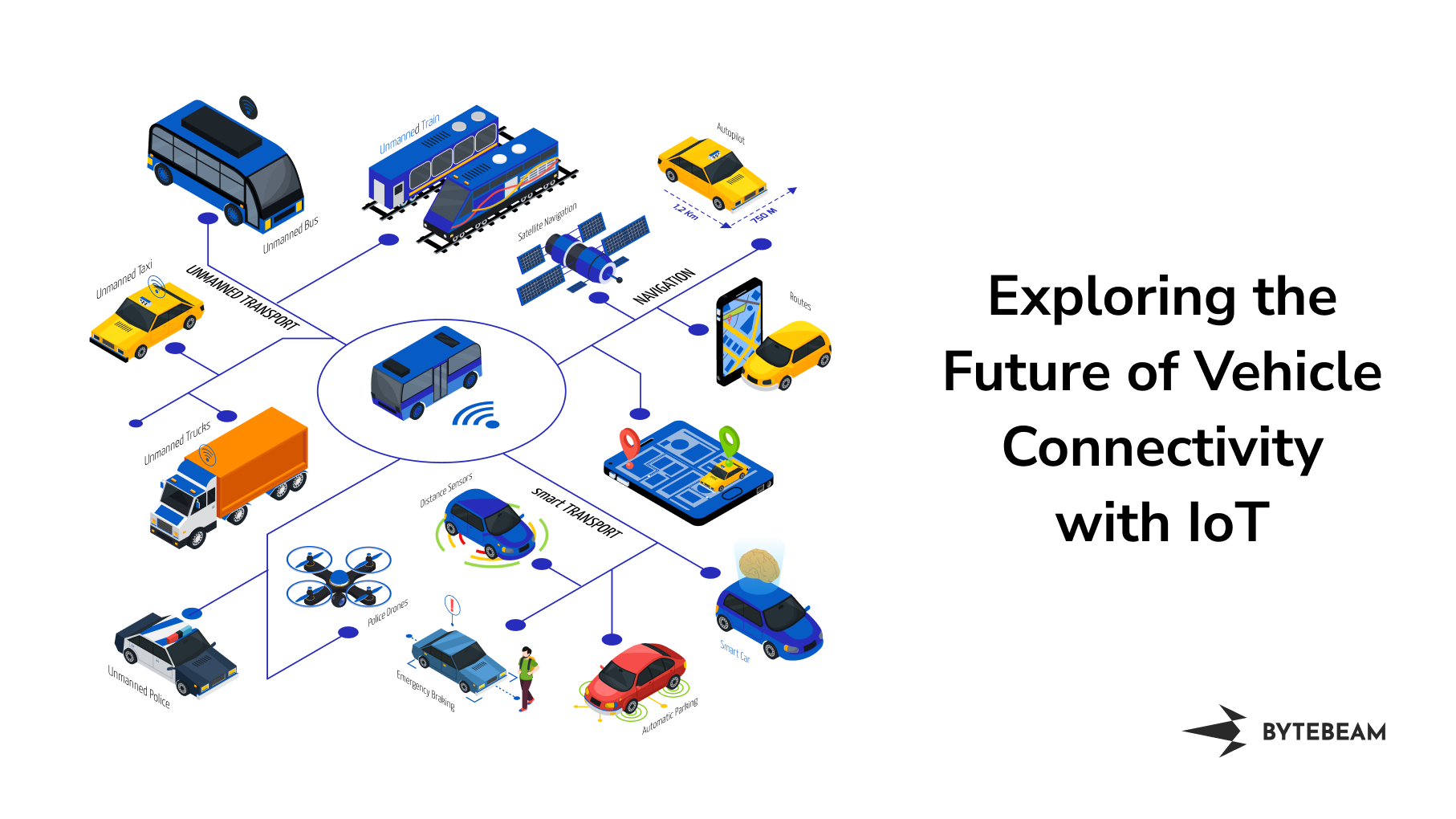Exploring the Future of Vehicle Connectivity with IoT

We live in a world where your phone can tell your air conditioner to turn on before you get home, your fridge can order milk online when you run out, and your car can notify your coffee maker to start brewing as you get close to home. This world of interconnected convenience is made possible by Internet of Things (IoT).
IoT is a network of physical devices that are connected to the internet and can exchange data with each other. These devices can be anything from household appliances, cars, industrial machines, and even wearable fitness devices.
The relevance of IoT in the modern world lies in its ability to make our lives more convenient, efficient, and even safer. Here are some ways how:
Convenience: With IoT, we can control various devices remotely from our smartphones or other connected devices. For example, you can adjust your home's thermostat or check your home security cameras from anywhere in the world.
Efficiency: IoT devices can communicate with each other and make decisions on their own without needing human intervention. For example, your car can communicate with your garage door to open it as you approach home.
Safety: IoT can help enhance safety in various ways. For example, in a connected car, the vehicle can communicate with other vehicles and traffic infrastructure to avoid collisions or warn about road hazards.
Cost Savings: By monitoring and optimizing the usage of resources like energy and water, IoT can help in reducing costs. For example, smart thermostats can learn your habits and adjust the temperature to save energy when you're not home.
Healthcare: IoT devices like wearable fitness trackers and connected medical devices can help in monitoring our health and providing real-time data to healthcare professionals.
IoT is incredibly relevant in the modern world as it offers numerous benefits by connecting devices and systems, making our lives more convenient, efficient, safe, and even healthy.
The Current Landscape of Vehicle Connectivity
The current state of vehicle connectivity is rapidly evolving. In the past, vehicle connectivity was primarily used for telematics services, such as tracking the location of a vehicle and providing diagnostic information. However, in recent years, there has been a growing focus on using vehicle connectivity for safety and convenience features.
Today, there are a variety of connected car technologies available, including cellular networks, Wi-Fi, and dedicated short-range communications (DSRC). Cellular networks are the most common type of connectivity for connected cars, as they offer wide coverage and high bandwidth. Wi-Fi can also be used for connected car applications, but it is typically limited to areas with Wi-Fi coverage. DSRC is a newer technology that is specifically designed for vehicle-to-vehicle (V2V) and vehicle-to-infrastructure (V2I) communication.
Vehicle connectivity is increasingly becoming a crucial part of modern vehicles, offering a range of benefits from enhanced safety and efficiency to convenience and predictive maintenance. For example, vehicle-to-vehicle communication can help avoid collisions and optimize traffic flow, while vehicle-to-infrastructure communication can help reduce congestion and improve fuel efficiency. Additionally, connected cars can offer a range of convenience features, from remote start and unlocking to real-time navigation updates and streaming music. Moreover, vehicle connectivity enables predictive maintenance, whereby your car can detect a potential problem before it becomes serious and notify you or your dealership, thus reducing breakdowns and maintenance costs.
However, the implementation of vehicle connectivity solutions is not without challenges. The increasing connectivity of vehicles brings a growing risk of cyberattacks, raising concerns about the security of the vehicles and the data they transmit. Additionally, the collection and transmission of data from vehicles raise privacy concerns, as there are questions about who has access to this data, how it is used, and how it is protected. Furthermore, the implementation of vehicle connectivity solutions can be expensive, as it involves the cost of the hardware and software required in the vehicle as well as the infrastructure needed to support vehicle connectivity. Another challenge is the interoperability of different vehicles and infrastructure, as different vehicle manufacturers may use different standards and technologies for vehicle connectivity, making it challenging to ensure seamless communication.
Despite these challenges, there are several key players in the market that are pioneering vehicle connectivity solutions. General Motors, for example, offers a range of services through its OnStar platform, including emergency services, navigation, remote start, and vehicle diagnostics. Tesla, a pioneer in vehicle connectivity, offers features like remote start, location tracking, and software updates over the air. BMW and Audi also offer a range of connected car services through their respective platforms, BMW ConnectedDrive and Audi Connect. Additionally, companies like Qualcomm and Cisco provide the underlying technology and infrastructure to enable vehicle connectivity, offering products for vehicle-to-everything communication, telematics, and infotainment.
The Role of IoT in Vehicle Connectivity
In the context of vehicle connectivity, IoT is enabling advancements by allowing vehicles to collect, exchange, and analyze data in real-time, which is essential for many of the features that make up vehicle connectivity.
Innovative IoT Applications in Vehicle Connectivity:
- Real-Time Traffic Updates: IoT enables vehicles to collect and exchange data about their location, speed, and direction. This data can be analyzed in real time to provide drivers with up-to-date traffic information, helping them to avoid congestion and reach their destination more quickly.
- Predictive Maintenance: Sensors in the vehicle can collect data about various components of the car, such as the engine, brakes, and tires. This data can be analyzed to predict when these components might fail or need maintenance. For example, if a sensor detects that the brake pads are wearing down, the car can alert the driver or schedule a service appointment.
- Autonomous Driving: This is one of the most advanced applications of vehicle connectivity. Sensors and actuators in the vehicle collect and analyze data about the vehicle's surroundings, such as the location of other vehicles, pedestrians, and road signs. This data is used to make real-time decisions about steering, acceleration, and braking, enabling the vehicle to drive itself without human intervention.
The Future of Vehicle Connectivity with IoT
The Internet of Things (IoT) is essentially enabling vehicles to become 'smarter' by connecting them to the internet and to each other. This opens up a world of possibilities for the future of vehicle connectivity.
Improved Safety: In the future, vehicles will be able to communicate with each other and with the road infrastructure even more seamlessly. This means that your car will know if another vehicle is about to run a red light and can warn you or even apply the brakes to avoid a collision.
Autonomous Driving: While there are already some autonomous vehicles on the road, IoT will make self-driving cars more common and more advanced. Vehicles will be able to make real-time decisions about steering, acceleration, and braking, based on data from sensors and other vehicles, enabling them to drive themselves without any human intervention.
Personalization: Your vehicle will be able to 'learn' your preferences and habits, such as your preferred driving routes, music choices, and climate control settings. This means that your car will be able to automatically adjust its settings to suit your preferences as soon as you get in.
Predictive Maintenance: Vehicles will be able to detect and diagnose issues before they become serious problems. For example, your car might be able to detect that its brake pads are wearing down and schedule a service appointment for you.
Traffic Optimization: By analyzing real-time traffic data, vehicles will be able to suggest the quickest and most efficient route to your destination, helping to reduce congestion and travel times.
Vehicle-to-Grid (V2G) Integration: This is a system where electric vehicles can communicate with the power grid to sell excess energy back to the grid or to draw energy from the grid when needed. This can help to balance the load on the grid and make energy use more efficient.
The potential future advancements in vehicle connectivity enabled by IoT include improved safety, autonomous driving, personalization, predictive maintenance, traffic optimization, and vehicle-to-grid integration. These advancements will make driving safer, more efficient, and more convenient.
Case Studies
Here are a few case studies of companies or projects that are pioneering the use of IoT in vehicle connectivity:
Tesla
Successes:
Tesla is one of the pioneers in the field of vehicle connectivity. Its electric vehicles are equipped with a host of sensors, cameras, and radar devices that constantly collect and analyze data to enable features like autopilot, collision avoidance, and real-time traffic updates. Tesla vehicles also receive over-the-air software updates that can add new features, improve performance, or fix issues, all without the need to visit a service center.
Challenges:
One of the main challenges faced by Tesla is related to the safety and reliability of its autonomous driving features. There have been several high-profile accidents involving Tesla vehicles on autopilot, raising concerns about the technology's readiness and safety.
Lessons Learned:
The experiences of Tesla highlight the importance of thorough testing and continuous improvement of autonomous driving technologies. It also underscores the importance of educating drivers about the limitations of these technologies and the need to remain attentive and in control at all times.
General Motors (GM) OnStar
Successes:
GM's OnStar is one of the oldest and most well-known vehicle connectivity services. It offers features like emergency services, navigation, remote start, and vehicle diagnostics. OnStar uses a combination of GPS and cellular technology to provide real-time connectivity and has been credited with saving lives in emergency situations.
Challenges:
One of the challenges faced by OnStar is related to privacy concerns. The service collects a lot of data about the vehicle and its location, raising concerns about how this data is used and protected.
Lessons Learned:
The experiences of OnStar highlight the importance of being transparent about the data collected and how it is used. It also underscores the importance of having robust security measures in place to protect this data.
Waymo
Successes:
Waymo, a subsidiary of Alphabet Inc. (Google's parent company), is a pioneer in the development of autonomous vehicles. It has developed a self-driving taxi service that operates in certain areas of Phoenix, Arizona. The vehicles use a combination of sensors, cameras, radar, and lidar to navigate and avoid obstacles. Waymo has collected millions of miles of driving data to train its algorithms and improve the performance of its vehicles.
Challenges:
One of the main challenges faced by Waymo is related to the limitations of current autonomous driving technology. The vehicles still struggle in certain situations, such as heavy rain or snow, and sometimes make mistakes that a human driver would not.
Lessons Learned:
The experiences of Waymo highlight the challenges of developing fully autonomous vehicles that can operate safely in all situations. It underscores the importance of collecting and analyzing vast amounts of data to train and improve the algorithms that control the vehicles.
The experiences of Tesla, GM OnStar, and Waymo highlight the potential of IoT in vehicle connectivity, but also the challenges related to safety, privacy, and the limitations of current technology. These case studies underscore the importance of thorough testing, continuous improvement, transparency, and robust security measures.
Wrapping up
The future of vehicle connectivity, enabled by the Internet of Things (IoT), is incredibly promising. From improving safety and enabling autonomous driving to personalization, predictive maintenance, and traffic optimization, the potential applications are vast and varied. Companies like Tesla, General Motors, and Waymo are pioneering the use of IoT in vehicle connectivity and have achieved notable successes, despite facing challenges related to safety, privacy, and technology limitations.
Ultimately, the advancements in vehicle connectivity enabled by IoT have the potential to revolutionize the way we travel, making it safer, more efficient, and more enjoyable.

